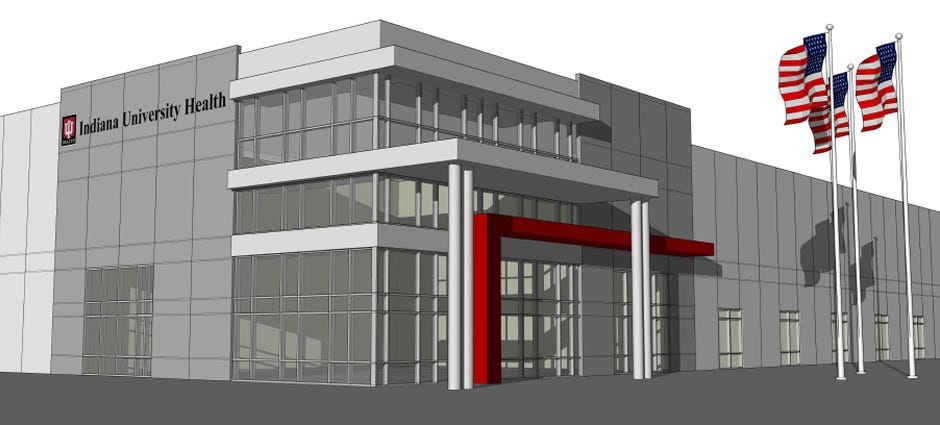IU Health Overhauls Logistics Plan, Builds Nerve Center
 The center will include an 18-robot system that picks supplies from stacks of bulk inventory.
The center will include an 18-robot system that picks supplies from stacks of bulk inventory.
Subscriber Benefit
As a subscriber you can listen to articles at work, in the car, or while you work out. Subscribe NowIt’s a behind-the-scenes function of a hospital that patients likely don’t even consider: how are the cabinets reliably stocked with syringes, latex gloves always within an arm’s reach—and even more critically—the right orthopedic implant ready for surgeons as they treat a trauma? Indiana University Health is overhauling its strategy for stocking its 15 hospitals and more than 200 clinics throughout the state, and it will be fueled by a new “ground-breaking,” high-tech centralized nerve center.
“We’re confident what we’re building is world-class. We did our homework,” says IU Health Supply Chain Operations Vice President Dennis Mullins. “It’s all about maximizing our economy as a system.”
The integrated service center (ISC) is the key component of IU Health’s new logistics plan; the 300,000 square-foot building in Plainfield will receive, hold and process inventory for the largest health care system in the state. Indianapolis-based Browning Investments Inc. is constructing and leasing the building to IU Health.
“For any health care organization, from an operating expense perspective, [supply expense] is second only to compensation and benefits for [employees],” says Mullins. “[Supplies] represent a good 25 to 30 percent of the operating expense of the organization. Creating savings for the organization is huge.”
IU Health expects to realize about $3 million in savings each year—which Mullins characterizes as a conservative estimate—by overhauling its method of obtaining supplies. Currently, each IU Health hospital purchases supplies from distributors that buy directly from the manufacturers. When the ISC is complete, IU Health will eliminate distributors and buy in bulk—for the entire system—directly from the manufacturers, avoiding handling fees from distributors.
Using a centralized location to manage such massive amounts of inventory requires cutting-edge technology. The $9 million worth of equipment IU Health has purchased for the ISC includes an 18-robot system that picks supplies from stacks of bulk inventory. Mullins says the level of technology in the ISC is unmatched anywhere in the country.
“We’ll be the first with this type of robotics in the center. It’s bins on top of bins, and robots are on the top. The robots are designed to pick the goods and bring them to the picker—a human—who is standing in one central location,” says Mullins. “We went with this technology because it allows us to increase the accuracy and velocity of our pick. We anticipate roughly 200 to 300 SKUs per hour; that’s at least double—maybe even triple—the rate of a human walking the shelves or driving the forklift to each bin location.”
The automation includes a software system that analyzes utilization patterns for nearly 5,000 products initially, determining what items should be stocked, where and how much.
“Data will drive all of our decisions,” says Mullins. “It gives us more control to manage exactly what we need; for example, our high-dollar implants. The challenge is every hospital that does these implant procedures has a cache of inventory. And when you look across the system, it may be more than we need. If you centralize the inventory and really just issue out as needed, I think we’ll carry less inventory.”
Mullins says IU Health selected Plainfield due to its proximity to the Indianapolis International Airport, interstates and UPS and FedEx facilities. All of IU Health’s hospitals are within 100 miles of the ISC and about a dozen clinics are within 60 miles. Initially, the health care system will outsource the delivery of the supplies from the center to hospitals and clinics, but Mullins says IU Health may bring that operation in-house in the future.
Phase one of the center is expected to be complete in mid-2017 and reach full capacity in 2018. While a hospital or clinic’s supply chain is likely never top of mind for patients, the system hopes to impact them by improving this behind-the-scenes operation.
“It’s all about patient care. We believe in having the right product, at the right place, at the right time, and it has to be the best product for clinicians and patients,” says Mullins. “We’re excited about being the first in the state and in the country to do the things we’ll be doing—and our ability to impact patient care in a positive way.”
Mullins says other large health care systems throughout the U.S. have centralized logistics centers, but the level of automation at the ISC will be unmatched.
Despite the high level of automation, Mullins says there will be no staff reductions.
